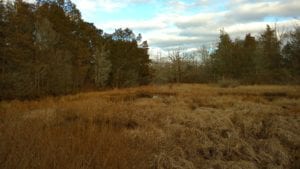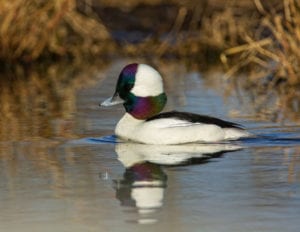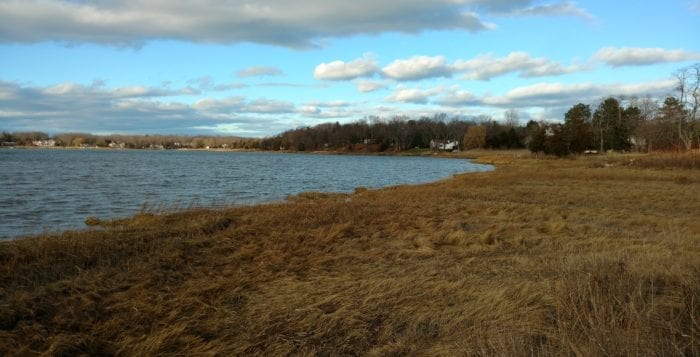By John Turner
One of the great joys of living in the Three Village area are the plethora of parks and preserves to be explored and enjoyed. These public spaces, true community assets, include the Frank Melville Memorial Park/Three Village Garden Club complex and Lee Koppelman Nature Preserve in Setauket; Patriots Hollow State Forest in East Setauket; and Forsythe Meadows County Park, the Town of Brookhaven’s West Meadow Beach, and the rambling, privately owned Avalon Preserve in Stony Brook.
We can now add another public property to the list to be savored: the small (7 acres) but beautiful state-owned property at the entrance to Strongs Neck. Offering commanding views of the eastern shore of Conscience Bay, it was purchased on our behalf by the NYS Department of Environmental Conservation last summer.

The entrance to the preserve is through a split rail fence along North Road. Here you’ll see the rock placed to recognize the contribution of the Besunder family who sold the property to the state. The trail passes by the plaqued rock and a small coastal salt pond on the right that is connected to the bay through a series of ditches in the salt marsh. Here I recently watched a great blue heron hunt for fish with zen-like patience, remaining perfectly still for minutes on end, lest it give away its presence due to some detectable movement.
The red cedars, along with pitch pine, the two more common coniferous trees native to Long Island, form thick stands throughout the property, growing in areas that are a few feet above the elevations of the surrounding marshland and only a few more feet above the high tide levels of Conscience Bay.
Thinking about the low-lying condition of this coastal forest caused a strong feeling of melancholy to usher over me, for I knew this forest, consisting of many hundreds of trees, will not likely survive more than two or three decades more. The cause for its ultimate demise? Elevated coastal waters due to sea level rise fueled by global warming.
In New York, sea levels are projected to rise, under the most optimistic conditions, 8 inches by the 2050s and, if the worse occurs, by 30 inches in the same period. Since 1900 they have already risen a foot due to the warming of ocean water with 8 inches of this rise having occurred over the past 50 years, indicating this rise is accelerating.
Given these projections, it is a certainty the property will lose its forests and very likely evolve into a salt marsh or into open water if the sea levels continue to rise. If this happens Strongs Neck will become “Strongs Island” and dozens of homes and businesses in the Three Village area will no longer be inhabitable.
The culprit for this unwanted change? Our stubborn refusal to enact the needed policies to limit carbon emissions by the amounts necessary and at a pace that’s rapid enough and a refusal colored by some “leaders” who still throw out the canard that global climate change is a myth.
Well, the best science is telling us that this “myth” is an incontrovertible “reality wall” that we will, with certainty, drive into with devastating consequences for us humans and the other living forms that share our planet — if we do not, very soon, begin to change course.
Soon I came out to the shore and my spirits brightened considerably, bathed as I was in this beautiful coastal scene of a gentle and sheltered harbor. Small wavelets lapped on the shoreline. Plus, seeing birds always helps the mood.

Along a distant shoreline a snow white American egret flew along, presumably heading to or from a feeding episode, and 150 yards from where I stood on the shore was a loose flock of buffleheads, a duck that is the definition of cuteness. The males are distinctive with their uniquely patterned heads — heads dominated by a white patch such that, if the duck’s head was a clock face, it would be white from 9 to 11 o’clock. The rest of the “clock” is dark and flashes iridescence from green to purple depending on the angle to the sun.
Flocks of buffleheads often dive synchronously leading to a “now-you-see-them, now-you-don’t” phenomenon as they dive below the surface to feed, before bobbing like released corks back to the surface. Where there were no ducks two seconds before, suddenly half a dozen are floating on the surface together.
Small as ducks go, their heads are large and that explains their common name. They were once called buffaloheads — shortened to buffleheads — since their heads were disproportionately large, just like the American buffalo (more accurately the American bison).
Buffleheads grace our coastal waters during the winter months.
As I walked out of the preserve and past the rock, I read the plaque and under my breath said, “Kudos to the Besunder family for committing to conservation and to the DEC for helping them to fulfill that commitment.” The images of buffleheads disappearing and re-emerging in the frigid waters of Conscience Bay, cavorting unconcerned about the elements, snug as they are in their feathered garb, stayed with me for the ride home.
A resident of Setauket, John Turner is conservation chair of the Four Harbors Audubon Society, author of “Exploring the Other Island: A Seasonal Nature Guide to Long Island” and president of Alula Birding & Natural History Tours.





